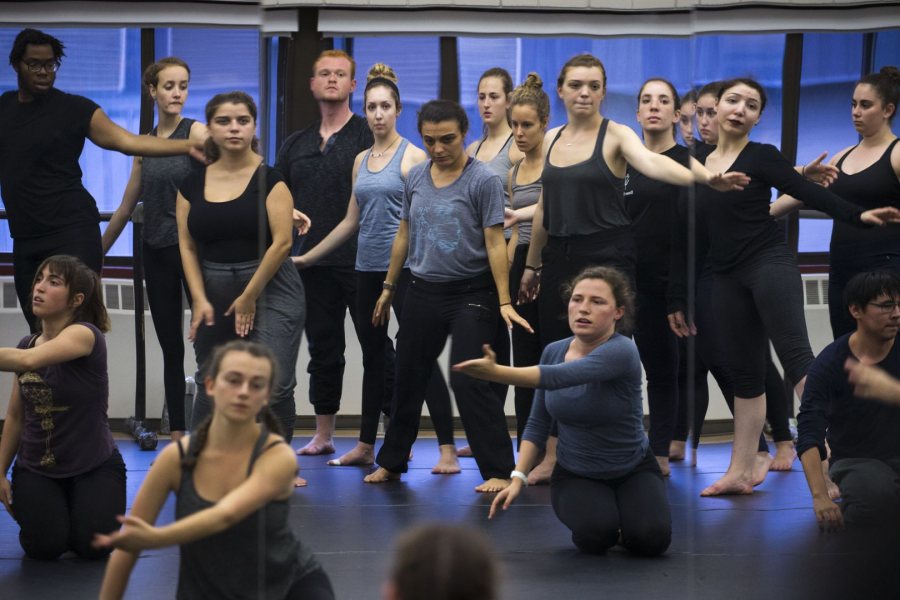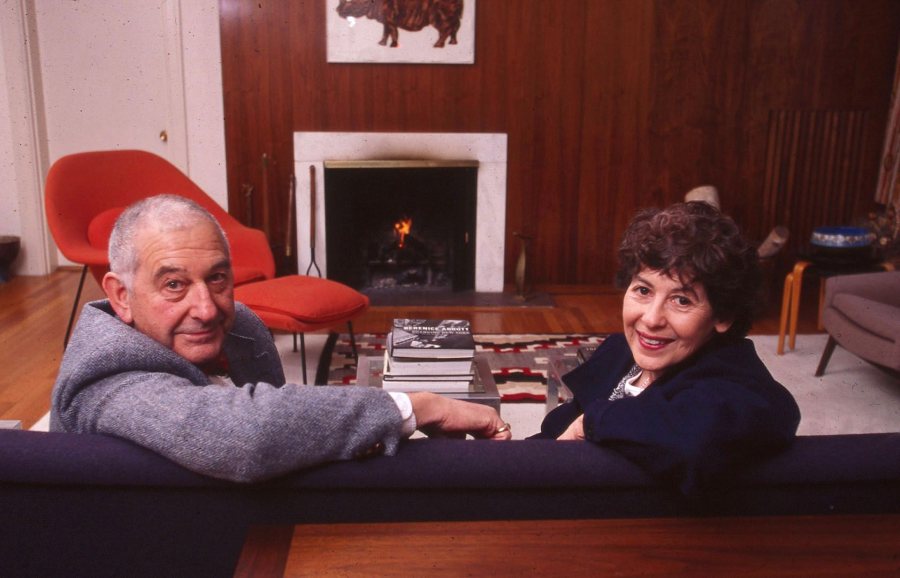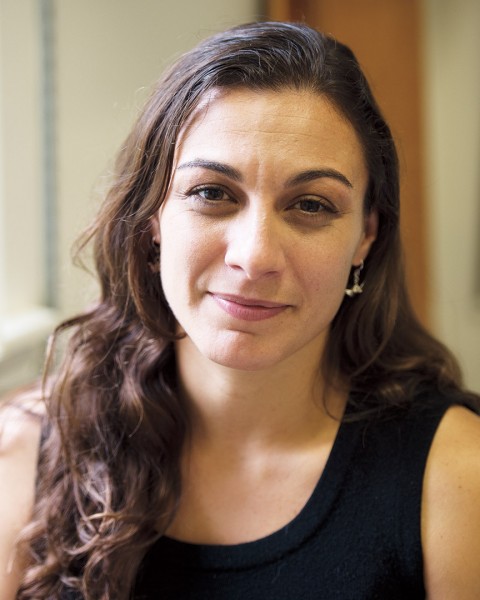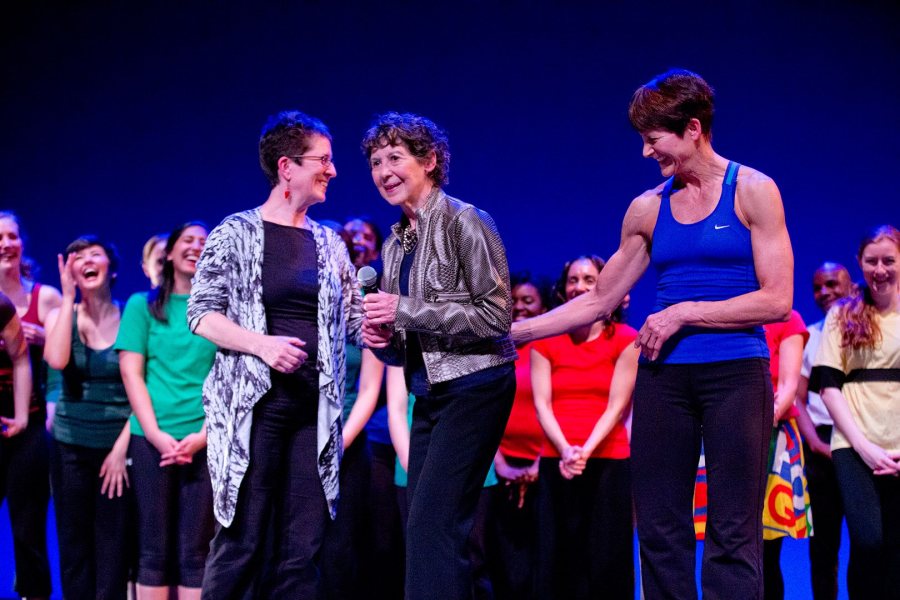
Marcy Plavin, who won a devoted following of friends as she built Bates’ academic dance program, often said that “modern dance is many points of view.”
From the very beginning of her work at Bates, in the 1960s, “Marcy never felt that dance students should only get her perspective or the perspective of any single faculty member,” says Rachel Boggia, associate professor of dance. “So we believe that exposing students to a lot of different artistic perspectives is important for them to understand the field.”

A pause for reflection: Students appear in a mirrored wall at the Marcy Plavin Dance Studio. The dancers are rehearsing the dance Passing, celebrating the life and works of dance program founder Plavin. (Theophil Syslo/Bates College)
Which makes it only fitting that the college has chosen to commemorate Plavin, who died in November 2016, by renaming, in perpetuity, its annual Fall Dance Concert after her. Known henceforth as the Marcy Plavin Fall Dance Concert, this event has always featured work by visiting dance artists.
“We choose them to bring diverse points of view about contemporary dance,” says Boggia, “so we felt that this concert really represents Marcy’s legacy in terms of the philosophy of the Bates dance program.”
This year’s program, in performances Dec. 2–4 in Schaeffer Theatre, incorporates work by recent visitors including Marlies Yearby, Vanessa Justice, and the late Trisha Brown, taught to the Bates company by Trisha Brown Dance Company member Samuel Wentz.
The Plavin concert also features thesis work by a senior, as well as Passing, a tribute to Plavin by Boggia, dance professor Carol Dilley, and composer William Matthews, Alice Swanson Esty Professor of Music.

Marcy and Leonard Plavin pose for a portrait at their Mountain Avenue home in 1999. (Phyllis Graber Jensen/Bates College)
A genuine Bates legend, Plavin brought heart and mind to building dance at the college. Her dedication to dance — and to her students, many of whom remained close friends long after graduation — was fierce, deep, and irresistible.
Marcy Plavin was predeceased, in 2010, by her husband, Leonard, an avid photographer of Bates dance. The couple’s children “wanted Bates to do something to honor Marcy,” says one of those children, David Plavin ’77.
It was Boggia who “suggested renaming the fall concert, and I thought it was a great idea,” says Plavin, whose siblings are Stephen Plavin and Lynda Plavin Fitzgerald ’79.
Previewed in September as a work in progress, Passing will be a fully realized premiere for the December performances. Dilley, who succeeded Plavin as head of Bates’ dance program and is on leave this year, returned to campus to collaborate with Boggia in creating the choreography for the 26 student dancers.
Matthews’ participation is striking in part, says Boggia, “because he did so many collaborations with Marcy over the years and was a big part of the dance program. For him to be accompanying this homage to her feels really right.”
As for the guest artists represented on the program, Yearby is known for her choreographic contributions to the Broadway hit Rent. At Bates, she worked with students on a piece reflecting concerns about genetically modified foods.
The work has a score by keyboardist Divyamaan Sahoo ’17, who will perform the music live for the Plavin performances. A double major in math and music from India, Sahoo has stayed on at Bates to work with the dance program as a guest composer and dance accompanist.
Justice’s piece on the Plavin program pays homage to the so-called analytic post-modern choreographers. Working in the 1970s, these dance artists minimized considerations of rhythm, musicality, and drama to achieve the purest possible focus on movement. Justice’s piece, set to music excerpted from Philip Glass’ Einstein on the Beach, “is hypnotic, interesting work,” says Boggia.
Justice has also worked with Bates dancers on the Alexander Technique, an approach to movement that enhances mindfulness and aims to resolve physical tensions and inefficiencies. “It’s a chance for our students to understand the kind of subtle training that supports a long life in dance,” says Boggia.
“This concert really represents Marcie’s legacy.”
The third visiting artist, Wentz, has taught the Bates dancers — or set on them, as dance artists say — Son of Gone Fishin’ Restaging Project, based on the original Son of Gone Fishin’, choreographed by Trisha Brown and premiered in the early 1980s. Wentz is a former member of Brown’s company who is now with Backhausdance, in California.
Offering senior thesis work is Riley Hopkins of Augusta, Maine. Presenting an excerpt from another Brown piece, Forêt Foray, Hopkins is Bates’ first dance major to undertake a thesis in performance, rather than choreography. (Performances of the complete Forêt Foray, Boggia notes, usually include a marching band playing outside the performance space. For his four-and-a-half-minute excerpt, Hopkins will use a recording.)
The student performers — and, of course, their audiences — will experience not only aesthetic but historical diversity in the inaugural Marcy Plavin Fall Dance Concerts, Boggia points out. Alongside the new work on the program, Justice’s work looks back to the 1970s, and the Trisha Brown pieces are from the 1980s and ’90s (Yearby’s work on Rent also dates to the 1990s).
“So, in some ways, all of these pieces are giving the students a sense of recent dance history from an experiential perspective.”



